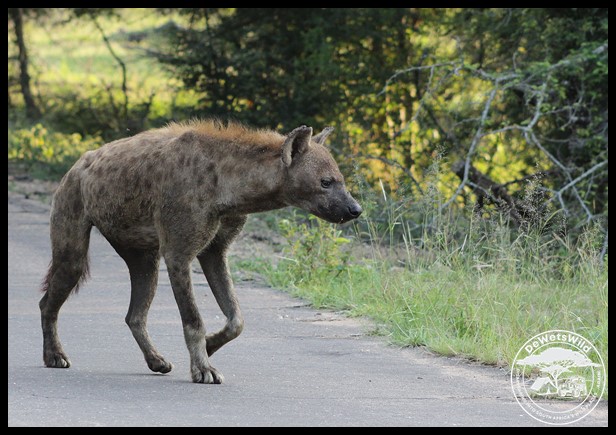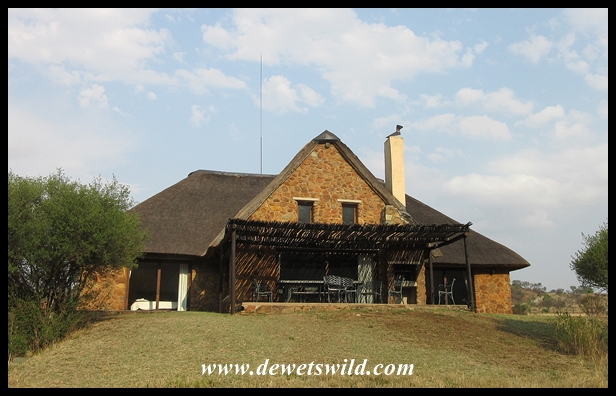Joubert and I were the first people out the gate at Skukuza on our first morning in the Kruger National Park when we visited last week. In the week before our arrival other visitors were bragging on the Park’s social media pages with their sightings of a big herd of sable antelope north of Lower Sabie, and as these rare and beautiful antelope are a favourite of ours, our route for the morning took us along the Sabie River and then in the general direction of the Mlondozi Picnic Spot. Along the way we had the joyful encounter with the young elephant knight we showed you two days ago.

Hippos returning to the hippo pool in the early morning

Nyala calf

Friendly Nyala bull ( (photo by Joubert)

Serene spot along the Sabie

Baboons huddling together in the rays of early morning

Blue Wildebeest

Kudu cow

Swainson’s Spurfowl

Black-bellied Bustard (photo by Joubert)

Black-bellied Bustard (photo by Joubert)

Steenbok ram

Steenbok with Muntshe Mountain in the background

Secretary Bird

Lesser Striped Swallow – welcome sign that spring is around the corner!

Elephant youngster wielding his weapon of choice

Elephant matriarch with impressive tusks

Fever Tree

Tawny Eagle in flight

Curious Slender Mongoose peeping from within a thornbush

Huge herds of plains zebra congregating along the Mnondozi stream
By the time we reached Mlondozi, we hadn’t yet found the sables we came looking for. We were planning on having brunch at the picnic spot, but it was packed with other visitors and not a single table was available. We spent a few minutes enjoying the view, getting pictures of the birds and animals, and waiting for a table to clear, but eventually decided to rather move along.

Blue Waxbill (photo by Joubert)

Dark-capped Bulbul

Swainson’s Spurfowl

The view from Mlondozi Picnic Site

Elephant coming to drink from Mlondozi Dam
We decided to use the extra time we had available due to the postponed lunch to do another circuit around Muntshe Mountain, and how wonderfully that turned out! We found the sables, and had probably the best sighting of these magnificent antelope I had in 30+ years! More about that soon, I promise.

Plains Zebras

Southern Reedbuck ewe (photo by Joubert)

Sable Antelope bull
Extremely satisfied with our morning, we headed for Lower Sabie where, just before the camp, we had a quick sighting of a leopard and enjoyed the abundant life that always congregate at the causeway over the Sabie River.

Wire-tailed Swallow

Huge Nile Crocodile at the Lower Sabie causeway
In contrast to Mlondozi, the picnic site at Lower Sabie was deserted, and Joubert and I could lunch in peace surrounded only by birds and butterflies.

Common Purple Tips

Green-backed Camaroptera (photo by Joubert)

Rattling Cisticola
By the time we finished lunch it was still too early to head back to Skukuza, so we drove south in the direction of Crocodile Bridge for a few kilometers along the main road, returning along the gravel Mativuhlungu Loop to Lower Sabie. Stopping at the causeway over the river again we were rewarded with a clear, though distant, view of an African Fish Eagle swooping down to snatch a catfish from the water. We’ll share that full sequence of pictures with you another day this coming week.

Buffalo herd drinking from the Sabie River

Bateleur cleaning up roadkill

Dwarf Mongoose

Male Bennett’s Woodpecker

Hooded Vulture

Serrated Hinged Terrapin (photo by Joubert)

Fish Eagle with catfish prey
Just outside Lower Sabie, on the way to Skukuza, Sunset Dam is always a great place to stop and sit for a while, just soaking in the sights and sounds of the bush. On this occasion however the usual serenity of the place was shattered when a pair of teenage male baboons savagely attacked a much younger baboon at the water’s edge, seemingly intent on killing it. Baboons are always fascinating to watch, but I definitely have never experienced such a disturbing glimpse into their behaviour before. We’ll share some pictures from this harrowing sighting this coming Saturday, but please be warned!

Yellow-billed Storks at Sunset Dam

Baboon murder
It’s just a 45km drive, but with so much to see along the way it still took us 3 hours to get back to Skukuza and we made it back into camp with just a minute or two to spare before the gates closed. Our last sighting of the day was a pack of African Wild Dogs guarding the scraps of their kill against a bunch of vultures – what more could we ask for after such a wonderful day!?

Lionesses and cubs laying claim to a Sand Bank in the Sabie River

Giraffe drinking from the Sabie River

Wary family of giraffes

Spotted Hyena

Impala Lily

White-crowned Lapwing

A slice of the riverine forest along the Sabie River

Hamerkop at sunset

Hippo in the Sabie River (photo by Joubert)

African Wild Dog on the alert
Before ending off, I have to show you these photographs of a family of white rhinoceros we came across on day 2 of our trip to the wilderness. I won’t disclose when and where we saw them though so as not to tip off any poachers.

White Rhino cow and calf

White Rhino bull








































































































































































































































































































